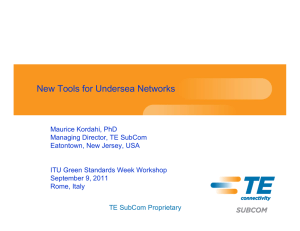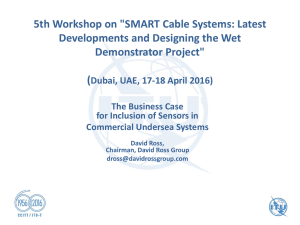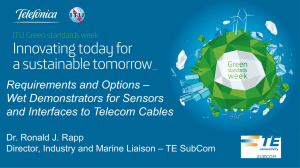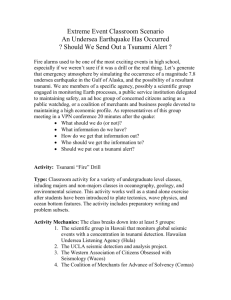Undersea Technology & Tools
advertisement
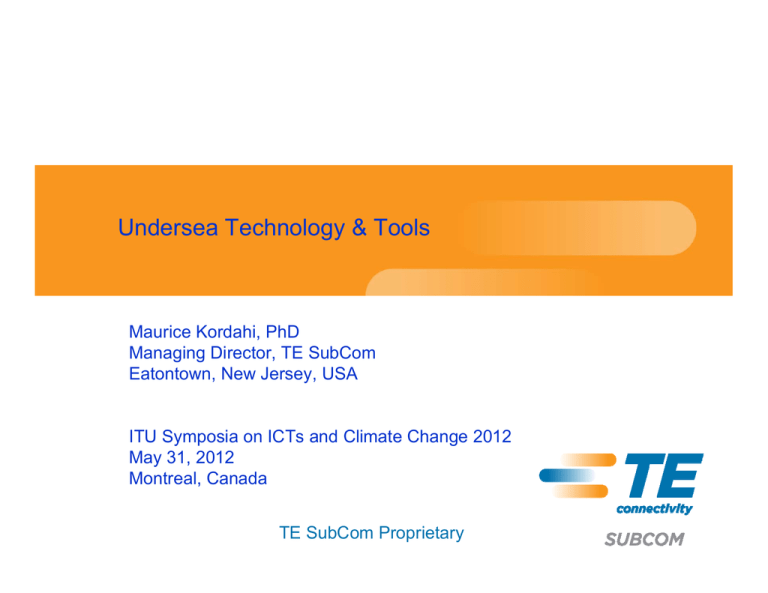
Undersea Technology & Tools Maurice Kordahi, PhD Managing Director, TE SubCom Eatontown, New Jersey, USA ITU Symposia on ICTs and Climate Change 2012 May 31, 2012 Montreal, Canada TE SubCom Proprietary Undersea Technology & Tools Outline Technology Building Blocks Challenges & Trade-offs Network Opportunities & Risks Observations - Sharing vs. Non-Sharing one Undersea Infrastructure TE SubCom Proprietary page 2 Undersea Hardware - SL Cables Armorless & Armored Cables Dynamic Riser Cables Dual Conductor Cables Optical Fibers Copper Conductor Steel Wires Polyethylene Insulation DCC TE SubCom Proprietary page 3 Undersea Hardware - SL Amplifiers Optical Amplifiers Joints & Couplings Millennia Joint TE SubCom Proprietary page 4 Undersea Hardware - SL OADM Branching Units 4-Port BU SL DCC 3-Port BU BU SL Cable SL Cable SL Cable TE SubCom Proprietary page 5 Undersea Hardware - SL Specialty Hardware Integrated Wet Mate Gateway Allows future network expansions TE SubCom Proprietary page 6 Challenges & Trade-Offs Network Differences – Data Topology Telecom Network Topology of Data Capacity needs Oil & Gas Network Scientific Network Data Transmission Data Transmission from Data Transmission across Oceans from end Oil & Gas Fields back across vast ocean to end to shore areas to shore Terabits – 100’s of Gigabits (nom.) most – Megabits (nom.) – wavelength @ 40/100G Distributed between Distributed between Concentrated between platforms sensors few landings TE SubCom Proprietary page 7 Classic Undersea Networks Technology Challenges – Power & Data connectivity & independence Telecom Network Characteristics: Oil & Gas Field Oil & Gas Field Scientific Interest High Reliability High Capacity (Terabits/sec) High Voltage ( 15KV) Powering the main trunk from two terminals Small number of fibers (< 20) Rapid Deep Water Installation (up to 7 knots) Rapid Repair (24 hr dispatch) Scientific Interest Modern Transoceanic Undersea Telecommunications Network Primary function is to push vast amount of data between population centers through large data pipes with minimal energy under the sea TE SubCom Proprietary page 8 Opportunities for Undersea Networks Dual Conductor Cable 4-Port Branching Unit SL Optical Add Drop Multiplexer BU Fiber Distribution Canister, etc. 3 Networks Limited Network “Independence” could be met through special hardware Non-telecom markets collect small distributed data and could use appreciable energy to operate sensors, lights, etc. TE SubCom Proprietary page 9 Sharing Undersea Networks ? Sharing the same undersea infrastructure presents difficult challenges to the different undersea communication markets: • Telecommunications (High speed & high capacity) • Oil & Gas (lower capacity, monitoring & control functions) • Scientific Research (lower capacity, monitoring & some control) • etc. • Technology Challenges – Power & Data connectivity & independence • Cost Challenges – Additional initial costs • Commercial Challenges – Ownership rights and priorities • Operation & Maintenance Challenges – Interdependence, Sparing & Restoration TE SubCom Proprietary page 10 Summary • Tools & Technology exist today to provide solutions to data gathering on the bottom of the ocean • Many of the tools presented here are qualified and have been used on many systems around the world • Appreciable funds are needed to implement such features into commercial systems • There are commercial challenges to be overcome to satisfy the needs of owners of the different sub-networks TE SubCom Proprietary page 11
